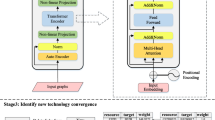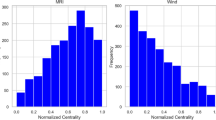Abstract
Technological advancement can provide new and more cost-effective solutions to challenges in critical areas. Therefore, as one of the important sources for technological progress, technological knowledge flow (TKF) forecasting, i.e., predicting the directional flows of knowledge from one technological field to another, has become a hot issue of widespread concern. However, existing researches either rely on labor-intensive empirical analysis or ignore the intrinsic characteristics inherent in TKF. To this end, we present a data-driven solution in this article, namely a hierarchical interactive multi-channel graph neural network (HIMTKF). Specifically, HIMTKF generates final predictions using two types of vector representations for each technology node (a diffusion vector and an absorption vector), which is realized by four components: high-order interaction module (HOI), co-occurrence module (CO), improved hierarchical delivery module (IHD) and technological knowledge flow tracing module (TFT). For one thing, HOI and CO are designed to represent high-order network relationships and co-occurrence relationships between technologies on the same hierarchy level. For another, IHD is aimed to model the hierarchical relationships between technologies while also taking their personalities into account. Then, TFT is intended for capturing the dynamic feature evolution of technologies with the above relations involved. Additionally, we develop a hybrid loss function and propose a new evaluation metric for better forecasting the unprecedented knowledge flows between technologies. Finally, we conduct extensive experiments on a large dataset of real-world patents. The results validate the effectiveness of our approach and shed light on several intriguing phenomena about technological knowledge flow trends.













Similar content being viewed by others

References
Aaldering LJ, Leker J, Song CH (2019) Competition or collaboration?—analysis of technological knowledge ecosystem within the field of alternative powertrain systems: a patent-based approach. J Clean Prod 212:362–371
Zhang L, Zhu H, Xu T, et al ( 2019) Large-scale talent flow forecast with dynamic latent factor model. In: The world wide web conference, pp 2312–2322
Song CH, Elvers D, Leker J (2017) Anticipation of converging technology areas—a refined approach for the identification of attractive fields of innovation. Technol Forecast Soc Chang 116:98–115
Song K, Kim K, Lee S (2017) Discovering new technology opportunities based on patents: text-mining and f-term analysis. Technovation 60–61:1–14
Abramo G, D’Angelo CA, Di Costa F (2020) The role of geographical proximity in knowledge diffusion, measured by citations to scientific literature. J Inform 14(1):101010
Emmanuel D, Megan M (2005) How well do patent citations measure flows of technology? Evidence from French innovation surveys. Dev Comput Syst 14(5):375–393
Zhang L, Li L, Li T (2015) Patent mining: A survey. ACM SIGKDD Explorations Newsl 16(2):1–19
Liu Y, Wu H, Huang Z et al (2020) Technical phrase extraction for patent mining: a multi-level approach. In: ICDM. IEEE, Sorrento, pp 1142–1147
Magerman T, Looy BV, Song X (2010) Exploring the feasibility and accuracy of latent semantic analysis based text mining techniques to detect similarity between patent documents and scientific publications. Scientometrics 82(2):289–306
Rui LI (2010) On the framing of patent citations and academic paper citations in reflecting knowledge linkage: a discussion of the discrepancy of their divergent value-orientations. Chin J Libr Inf Sci 3:37–45
Chen L (2017) Do patent citations indicate knowledge linkage? The evidence from text similarities between patents and their citations. J Informetr 11(1):63–79
Wu H, Zhang K, Lv G et al (2019) Deep technology tracing for high-tech companies. In: ICDM. IEEE, New York, pp 1396–1401
Kim J, Magee CL (2017) Dynamic patterns of knowledge flows across technological domains: empirical results and link prediction. SSRN Electron J
Alcacer J, Gittelman M (2006) Patent citations as a measure of knowledge flows: the influence of examiner citations. Rev Econ Stat 88(4):774–779
Goodman CM (1987) The Delphi technique: a critique. J Adv Nurs 12(6):729–734
Ko N, Yoon J, Seo W (2014) Analyzing interdisciplinarity of technology fusion using knowledge flows of patents. Expert Syst Appl 41(4):1955–1963
Smojver V et al (2020) Exploring knowledge flow within a technology domain by conducting a dynamic analysis of a patent co-citation network. J Knowl Manag 25
Liu H, Wu H, Zhang L et al (2021) Technological knowledge flow forecasting through a hierarchical interactive graph neural network. In: ICDM. IEEE, Auckland, New Zealand, pp 389–398
Acemoglu D, Akcigit U, Kerr WR (2016) Innovation network. Proc Natl Acad Sci 113(41):11483–11488
Porter A, Cunningham S (2006) Tech mining: exploiting new technologies for competitive advantage. Technol Forecast Soc Chang 73:91–93
Harb YA, Abu-Shanab E (2020) A descriptive framework for the field of knowledge management. Knowl Inf Syst 62(12):4481–4508
Verhaegen PA, D’Hondt J, Vertommen J et al (2009) Relating properties and functions from patents to TRIZ trends. CIRP J Manuf Sci Technol 1(3):126–130
Cho Y, Kim E, Kim W (2015) Strategy transformation under technological convergence: evidence from the printed electronics industry. Soc Sci Electron Publ 674(67):106–131
Park I, Yoon B (2018) Technological opportunity discovery for technological convergence based on the prediction of technology knowledge flow in a citation network. J Informetr 12(4):1199–1222
Lee J, Kim C, Shin J (2017) Technology opportunity discovery to R &D planning: key technological performance analysis. Technol Forecast Soc Chang 119:53–63
Lü L, Zhou T (2011) Link prediction in complex networks: a survey. Physica A 390(6):1150–1170
Zhou T et al (2009) Predicting missing links via local information. Eur Phys J B 71(4):623–630
Adamic LA, Adar E (2003) Friends and neighbors on the web. Soc Netw 25(3):211–230
Sasaki H, Sakata I (2020) Identifying potential technological spin-offs using hierarchical information in international patent classification. Technovation 102192
Lee WS, Han EJ, Sohn SY (2015) Predicting the pattern of technology convergence using big-data technology on large-scale triadic patents. Technol Forecast Soc Chang 100:317–329
Yang C, Huang C, Su J (2018) An improved SAO network-based method for technology trend analysis: a case study of graphene. J Informetr 12(1):271–286
Yoon B, Park Y (2004) A text-mining-based patent network: analytical tool for high-technology trend. J High Technol Manag Res 15(1):37–50
Gori M, Monfardini G, Scarselli F (2005) A new model for learning in graph domains. In: IJCNN, vol. 2. IEEE, Montreal, QC, Canada, pp 729–734
Estrach JB, Zaremba W, Szlam A et al (2014) Spectral networks and deep locally connected networks on graphs. In: ICLR
Defferrard M, Bresson X, Vandergheynst P (2016) Convolutional neural networks on graphs with fast localized spectral filtering. In: NeurIPS, pp 3844–3852
Kipf TN, Welling M (2017) Semi-supervised classification with graph convolutional networks. In: ICLR
Velikovi P, Cucurull G, Casanova A et al (2018) Graph attention networks. In: ICLR
Hamilton WL, Ying R, Leskovec J (2017) Inductive representation learning on large graphs. In: NeurIPS, Long Beach, CA, USA, pp 1025–1035
Wang X, Zhu M, Bo D et al (2020) AM-GCN: adaptive multi-channel graph convolutional networks. In: ACM SIGKDD. Association for Computing Machinery, New York, pp 1243–1253
Guo X, Zhao L, Homayoun H et al (2021) Deep graph transformation for attributed, directed, and signed networks. Knowl Inf Syst 63(6):1305–1337
Schlichtkrull M, Kipf TN, Bloem P et al (2018) Modeling relational data with graph convolutional networks. In: European semantic web conference. Springer, Cham, pp 593–607
Toujani R, Akaichi J (2019) An approach based on mixed hierarchical clustering and optimization for graph analysis in social media network: toward globally hierarchical community structure. Knowl Inf Syst 60(2):907–947
Sankar A, Wu Y, Gou L et al (2020) Dysat: deep neural representation learning on dynamic graphs via self-attention networks. In: WSDM, pp 519–527
Zhang J, Li M, Gao K et al (2021) Word and graph attention networks for semi-supervised classification. Knowl Inf Syst 63(11):2841–2859
Li W, Xiao X, Liu J et al (2020) Leveraging graph to improve abstractive multi-document summarization. arXiv preprint arXiv:2005.10043
Wang H, Lian D, Tong H et al (2021) Hypersorec: exploiting hyperbolic user and item representations with multiple aspects for social-aware recommendation. ACM Trans Inf Syst (TOIS) 40(2):1–28
Mauw S, Ramírez-Cruz Y, Trujillo-Rasua R (2019) Conditional adjacency anonymity in social graphs under active attacks. Knowl Inf Syst 61(1):485–511
You H et al (2017) Development trend forecasting for coherent light generator technology based on patent citation network analysis. Scientometrics 111(1):297–315
Clough JR, Gollings J, Loach TV et al (2015) Transitive reduction of citation networks. J Complex Netw 3(2):189–203
Liu Q, Wu H, Ye Y et al (2018) Patent litigation prediction: a convolutional tensor factorization approach. In: IJCAI. AAAI Press, Stockholm
Lobo J et al (2019) Sources of inventive novelty: two patent classification schemas, same story. Scientometrics 120(1):19–37
Kapoor R, Karvonen M, Ranaei S et al (2015) Patent portfolios of European wind industry: new insights using citation categories. World Patent Inf 41:4–10
Liu Q, Ge Y, Li Z et al (2011) Personalized travel package recommendation. In: 2011 IEEE 11th international conference on data mining. IEEE, Vancouver, pp 407–416
Ernst H (1999) Evaluation of dynamic technological developments by means of patent data. In: The dynamics of innovation. Springer, Berlin, pp 103–132
He X, Deng K, Wang X et al (2020) Lightgcn: simplifying and powering graph convolution network for recommendation. In: ACM SIGIR, pp 639–648
Jeon J, Suh Y (2019) Multiple patent network analysis for identifying safety technology convergence. Data Technol Appl
Shi C, Han X, Song L et al (2021) Deep collaborative filtering with multi-aspect information in heterogeneous networks. IEEE Trans Knowl Data Eng 33(4):1413–1425
Hochreiter S, Schmidhuber J (1997) Long short-term memory. Neural Comput 9(8):1735–1780
Liu Q, Huang Z, Yin Y et al (2021) EKT: exercise-aware knowledge tracing for student performance prediction. IEEE Trans Knowl Data Eng 33(1):100–115
Kipf TN, Welling M (2016) Variational graph auto-encoders. In: Bayesian deep learning workshop, NeurIPS (2016)
Caviggioli F (2016) Technology fusion: identification and analysis of the drivers of technology convergence using patent data. Technovation 55–56:22–32
Lee DD, Seung HS (1999) Learning the parts of objects by non-negative matrix factorization. Nature 401(6755):788–791
Yu R, Liu Q, Ye Y et al (2020) Collaborative list-and-pairwise filtering from implicit feedback. IEEE Trans Knowl Data Eng
Hu W, Gao J, Li B et al (2020) Anomaly detection using local kernel density estimation and context-based regression. IEEE Trans Knowl Data Eng 32(2):218–233
Glorot X, Bengio Y (2010) Understanding the difficulty of training deep feed forward neural networks. J Mach Learn Res 9:249–256
Kingma DP, Ba J (2015) Adam: a method for stochastic optimization. In: ICLR
Zhao H, Liu Q, Zhu H et al (2018) A sequential approach to market state modeling and analysis in online P2P lending. IEEE Trans Syst Man Cybern Syst 48(1):21–33
Acknowledgements
This research was partially supported by grants from the National Natural Science Foundation of China (Grants No. U20A20229, 61922073 and 71802068).
Author information
Authors and Affiliations
Corresponding author
Additional information
Publisher's Note
Springer Nature remains neutral with regard to jurisdictional claims in published maps and institutional affiliations.
Rights and permissions
About this article
Cite this article
Liu, H., Wu, H., Zhang, L. et al. A hierarchical interactive multi-channel graph neural network for technological knowledge flow forecasting. Knowl Inf Syst 64, 1723–1757 (2022). https://doi.org/10.1007/s10115-022-01697-2
Received:
Revised:
Accepted:
Published:
Issue Date:
DOI: https://doi.org/10.1007/s10115-022-01697-2



